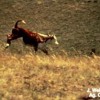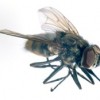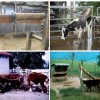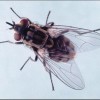 Immature warble flies, or cattle grubs, infest and harm livestock throughout the world. Warble flies also are known as “heel flies” because they cause cattle to kick at themselves, and “gad flies” because they cause cattle to “gad about” in an attempt to evade the flies. Two species of cattle grubs occur in the U.S.A., the common cattle grub, and the northern cattle grub. This 6-page fact sheet was written by P. E. Kaufman and E. N. I. Weeks, and published by the UF Department of Entomology and Nematology, March 2013.
Immature warble flies, or cattle grubs, infest and harm livestock throughout the world. Warble flies also are known as “heel flies” because they cause cattle to kick at themselves, and “gad flies” because they cause cattle to “gad about” in an attempt to evade the flies. Two species of cattle grubs occur in the U.S.A., the common cattle grub, and the northern cattle grub. This 6-page fact sheet was written by P. E. Kaufman and E. N. I. Weeks, and published by the UF Department of Entomology and Nematology, March 2013.
http://edis.ifas.ufl.edu/in979
Tag: Cattle Pest Insects
Horn Fly Management (ENY288/IN952)
 Horn flies are one of the livestock pests with the greatest impact on the health and productivity of cattle. Economic losses due to horn fly damage are estimated at $36 million annually in Florida alone. In the U.S.A. annual losses total between $700 million and $1 billion, with up to $60 million spent on insecticidal control. Horn fly damage is caused by blood feeding. The flies feed frequently and exclusively on blood, piercing the skin of cattle with their proboscis and taking around 20 small blood meals each day. Pain and irritation due to the constant presence of the flies and their bites causes defensive behavior in the cattle that prevents adequate food consumption and rest. This 4-page fact sheet was written by P. E. Kaufman and E. N. I. Weeks, and published by the UF Department of Entomology and Nematology, September 2012.
Horn flies are one of the livestock pests with the greatest impact on the health and productivity of cattle. Economic losses due to horn fly damage are estimated at $36 million annually in Florida alone. In the U.S.A. annual losses total between $700 million and $1 billion, with up to $60 million spent on insecticidal control. Horn fly damage is caused by blood feeding. The flies feed frequently and exclusively on blood, piercing the skin of cattle with their proboscis and taking around 20 small blood meals each day. Pain and irritation due to the constant presence of the flies and their bites causes defensive behavior in the cattle that prevents adequate food consumption and rest. This 4-page fact sheet was written by P. E. Kaufman and E. N. I. Weeks, and published by the UF Department of Entomology and Nematology, September 2012.
http://edis.ifas.ufl.edu/in952
Self-Treatment Methods for Livestock–Backrubbers (ENY279/IG134)
 Back rubbers are a method of pesticide self-treatment for cattle. When bothered by insects or other pests, cattle tend to rub against objects. Backrubbers provide a rubbing surface that is treated with a pesticide. Cattle self-treat during rubbing, which reduces the number of flies, particularly horn flies, and parasites such as lice, on the animal. Backrubbers may be purchased commercially or constructed from easily available materials. A properly designed backrubber that supplies pesticide reliably to the animal can be a valuable addition to an integrated pest management program. This 4-page fact sheet was written by E. N. I. Weeks and P. E. Kaufman, and published by the UF Department of Entomology and Nematology, September 2012.
Back rubbers are a method of pesticide self-treatment for cattle. When bothered by insects or other pests, cattle tend to rub against objects. Backrubbers provide a rubbing surface that is treated with a pesticide. Cattle self-treat during rubbing, which reduces the number of flies, particularly horn flies, and parasites such as lice, on the animal. Backrubbers may be purchased commercially or constructed from easily available materials. A properly designed backrubber that supplies pesticide reliably to the animal can be a valuable addition to an integrated pest management program. This 4-page fact sheet was written by E. N. I. Weeks and P. E. Kaufman, and published by the UF Department of Entomology and Nematology, September 2012.
http://edis.ifas.ufl.edu/ig134
Stable Fly (Dog Fly) Control (ENY267/IG133)
 The stable fly is a blood-sucking filth fly of considerable importance to people, pets, livestock, and the tourist industry in Florida. Filth flies, including stable flies, exploit habitats and food sources created by human activities, such as farming. Stable flies primarily attack animals for a blood meal, but in the absence of an animal host, they will bite people. This 4-page fact sheet was written by P. E. Kaufman and E. N. I. Weeks, and published by the UF Department of Entomology and Nematology, August 2012.
The stable fly is a blood-sucking filth fly of considerable importance to people, pets, livestock, and the tourist industry in Florida. Filth flies, including stable flies, exploit habitats and food sources created by human activities, such as farming. Stable flies primarily attack animals for a blood meal, but in the absence of an animal host, they will bite people. This 4-page fact sheet was written by P. E. Kaufman and E. N. I. Weeks, and published by the UF Department of Entomology and Nematology, August 2012.
http://edis.ifas.ufl.edu/ig133
Horn Fly Haematobia irritans irritans (Linnaeus) (Insecta: Diptera: Muscidae) (EENY490/IN885)
The horn fly is one of the most economically important pests of cattle worldwide. Just in the United States, hundreds of millions of dollars in losses are attributed to the horn fly annually, while additional millions are spent annually on insecticides to reduce horn fly numbers. Learn more about this pernicious obligate blood-feeding ectoparasite in this 7-page fact sheet, written by Dan Fitzpatrick and Phillip E. Kaufman, and published by the UF Department of Entomology and Nematology, April 2011.
http://edis.ifas.ufl.edu/in885
External Parasites on Beef Cattle (ENY274/IG130)
External parasites such as lice, flies, ticks, cattle grubs and mites are a serious problem to livestock breeders. These pests are most prevalent during spring and summer months; however, Florida's warm climate permits many pests to live year-round.
This revised 13-page fact sheet was written by P. E. Kaufman, P. G. Koehler and J. F. Butler, and published by the UF Department of Entomology and Nematology, April 2011.
http://edis.ifas.ufl.edu/ig130
ENY251/IG050 External Parasites of Dairy Cattle
Revised! ENY-251, a 23-page fact sheet by P. E. Kaufman, P. G. Koehler and J. F. Butler, describes the biology and management of the most important external parasites of dairy cattle in Florida. Includes references and tables of pesticide information. Published by the UF Department of Entomology and Nematology, May 2009.
http://edis.ifas.ufl.edu/IG050
ENY281/IG135 Management of External Parasites with Forced-Use Dust Bags
Revised! ENY-281, a 7-page illustrated fact sheet by P. E. Kaufman, P. G. Koehler and J. F. Butler, describes this safe, economical, and effective technique for managing external parasites on cattle in Florida — background, directions for hanging commercial dust bags, safety, cost of treatment, and effectiveness. Includes references. Published by the UF Department of Entomology and Nematology, April 2009.
http://edis.ifas.ufl.edu/IG135
EENY422/IN798 Little Blue Cattle Louse Solenopotes capillatus (Enderlein) (Insecta: Phthiraptera: Anoplura: Linognathidae)
EENY-422, a 4-page illustrated fact sheet by Kevyn J. Juneau and Phillip E. Kaufman, is part of the Featured Creatures collection. It describes the smallest of the five sucking lice that feed on cattle, its distribution, description, biology, hosts, economic importance and management. Includes selected references. Published by the UF Department of Entomology and Nematology, February 2009.
http://edis.ifas.ufl.edu/IN798